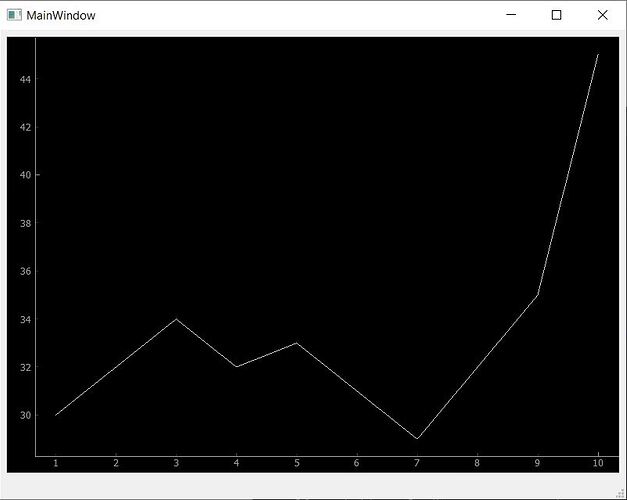Adri1G | 2020-06-18 09:10:48 UTC | #1
I followed the Embed PyQtgraph tutorial. I tried to write the code to use PySide2. But I don't find the equivalent function to remplace graphWidget (PyQt5). Do you have any suggestion?
# from PyQt5 import QtWidgets, uic # import for PyQt
from PySide2 import QtWidgets
from qtpy import uic
import sys # We need sys so that we can pass argv to QApplication
class MainWindow(QtWidgets.QMainWindow):
def __init__(self, *args, **kwargs):
super().__init__(*args, **kwargs)
uic.loadUi('mainwindow.ui', self) # Load the UI Page
self.plot([1, 2, 3, 4, 5, 6, 7, 8, 9, 10], [30, 32, 34, 32, 33, 31, 29, 32, 35, 45])
def plot(self, hour, temperature):
self.plot(hour, temperature) # PySide2, work but plot out the main window
# self.graphWidget.plot(hour, temperature) # PyQt5
def main():
app = QtWidgets.QApplication(sys.argv)
main = MainWindow()
main.show()
sys.exit(app.exec_())
if __name__ == '__main__':
main()
````
-------------------------
Luca | 2020-06-19 21:02:26 UTC | #2
Hi Adri,
graphWidget is not a function of PyQt5.
graphWidget is an instance of the class PlotWidget imported from the pyqtgraph.
-------------------------
martin | 2020-06-30 12:49:11 UTC | #3
@Adri1G the main problem is you're using Qt.py but not setting which Python Qt API to use and so it is defaulting to PyQt5. See [the Requirements section here for possible values](https://pypi.org/project/QtPy/).
To set that in your code, you can just `import os` and then set the value on `os.environ`.
The following code works for me with PySide2.
import os
os.environ['QT_API'] = 'pyside2'
from PySide2 import QtWidgets
from qtpy import uic import sys # We need sys so that we can pass argv to QApplication
class MainWindow(QtWidgets.QMainWindow): def init(self): super().init()
Purchasing Power Parity
Developers in [[ country ]] get [[ discount.discount_pc ]]% OFF on all books & courses with code [[ discount.coupon_code ]] uic.loadUi('mainwindow.ui', self) # Load the UI Page
self.plot([1, 2, 3, 4, 5, 6, 7, 8, 9, 10], [30, 32, 34, 32, 33, 31, 29, 32, 35, 45])
def plot(self, hour, temperature):
self.graphWidget.plot(hour, temperature) # PyQt5
def main(): app = QtWidgets.QApplication(sys.argv) main = MainWindow() main.show() sys.exit(app.exec_())
if name == 'main': main() ```
That gives the same plot as for the PyQt5 version.
Create GUI Applications with Python & Qt5 by Martin Fitzpatrick — (PySide2 Edition) The hands-on guide to making apps with Python — Over 10,000 copies sold!

Adri1G | 2020-06-30 12:49:40 UTC | #4
Ok. Thank you for your response :slight_smile:
PyQt/PySide 1:1 Coaching with Martin Fitzpatrick — Get one on one help with your Python GUI projects. Working together with you I'll identify issues and suggest fixes, from bugs and usability to architecture and maintainability.

